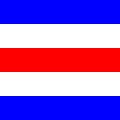Top Qs
Timeline
Chat
Perspective
Ni (kana)
Character of the Japanese writing system From Wikipedia, the free encyclopedia
Remove ads
に, in hiragana, or ニ in katakana, is one of the Japanese kana, which each represent one mora. The hiragana is written in three strokes, while the katakana in two. Both represent /ni/ although for phonological reasons, the actual pronunciation is [ɲi].
Notably, the katakana (ニ) is functionally identical to the kanji for two (二), pronounced the same way, and written similarly.
に is used as a particle, with a similar function to the English "to", "in", "at", or "by":
トン
"Ton
は、
wa,
フランス
Furansu
に
ni
行きました。
ikimashita."
"Ton went to France."
パン
"Pan
は、
wa,
トン
Ton
に
ni
上げました。
agemashita."
"Bread was given 'to' Ton"
六時
"Rokuji
に
ni
しました。
shimashita."
"(I) did it at 6 o'clock."
Remove ads
Stroke order
 |
 |

The hiragana に is made with three strokes:
- A vertical stroke from top to bottom.
- A short, horizontal stroke to the upper right of the first stroke, going from left to right.
- Another short, horizontal stroke at the bottom right of the first stroke, going from left to right.

The katakana ニ is made with two strokes:
- At the top, a horizontal stroke from left to right.
- Another, longer horizontal stroke under the first stroke
Remove ads
Other communicative representations
| Japanese radiotelephony alphabet | Wabun code |
| 日本のニ Nippon no "Ni" |
ⓘ |
 |
 |
 | |
| Japanese Navy Signal Flag | Japanese semaphore | Japanese manual syllabary (fingerspelling) | Braille dots-123 Japanese Braille |
- Full Braille representation
Remove ads
See also
References
Wikiwand - on
Seamless Wikipedia browsing. On steroids.
Remove ads


